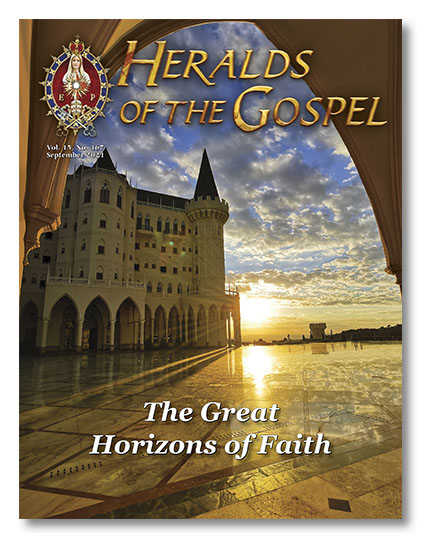Contrary to what certain sugar-coated and fainthearted concepts of religion insinuate, Our Lord Jesus Christ invites His disciples to be “the light of the world,” that is, to shine before men, so that these, seeing their good works, may glorify the Father who is in Heaven (cf. Mt 5:14-16). Moreover, He urges them to seek out ever wider horizons and to cast their nets into deeper waters (cf. Lk 5:4).
Our Lord gave constant example of this in His public life by performing works that aroused admiration (cf. Mt 9:33; Mk 2:12; 9:15; 10:24). He also urged His followers to become great in the Kingdom of Heaven (cf. Mt 5:19) and affirmed that it is the violent who attain it (cf. Mt 11:12).
Following in the footsteps of the Divine Master, St. Paul did not hesitate to present himself as a model to the recipients of his letters: “Be imitators of me” (cf. Phil 3:17; 1 Cor 11:1). Humility is truth, St. Teresa said, and for this reason the Apostle did not hide his light under a bushel, but showed it fearlessly to others.
This brings to the fore two virtues which have been practically relegated to oblivion in today’s ocean of mediocrity, including apostolic mediocrity. They are magnanimity and magnificence, which, briefly put, mean having a generous soul and desiring to do great things.
These virtues, like all others, are participations in the divine perfection, for God is supremely magnanimous and magnificent. Moreover, they have distinguished the Saints, precisely because these practised all the virtues to a heroic degree.
Both of these qualities shone even in St. Francis, the “poor man of Assisi”, who spared no effort to ensure that sacred vessels were fashioned of precious metals and adorned in a manner worthy of the Body and Blood of Jesus. Called “the new Knight of Christ” by his main biographer, Thomas of Celano, the Poverello had no misgivings in referring to himself as “Herald of the Great King.”
We find another example of these virtues in St. Jean-Marie Vianney, so simple and even uneducated, but about whom a lawyer who had visited Ars said: “I saw God in a man.” And the Curé of Ars himself recognized his charism: “What a great thing it is to be a priest! if I could comprehend it completely, I would die.”
We can say that even the giving of the widow’s last mite (cf. Lk 21:1-4), though in itself an insignificant act, became a truly magnificent one because it was done with nobility of soul.
According to St. Thomas Aquinas, magnificence also concerns the right use of reason in art, as in the preparation of festive celebrations and the construction of buildings fitting for their purpose (cf. Summa Theologiae. II-II, q.134, a.1, ad 3).
In a world trending increasingly towards mechanization and the multiplication of superfluous and banal objects, towards pauperism in ways of being and acting, in short, towards pusillanimity and stinginess, it becomes necessary to strive for great horizons. And the Church has a fundamental role in this task, especially when presented as she truly is: “in splendour, without spot or wrinkle or any such thing, that she might be holy and without blemish” (Eph 5:27). ◊




